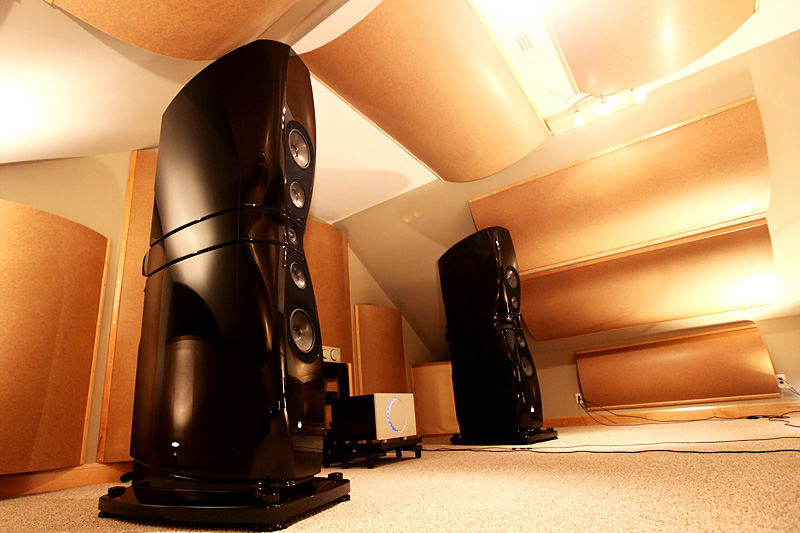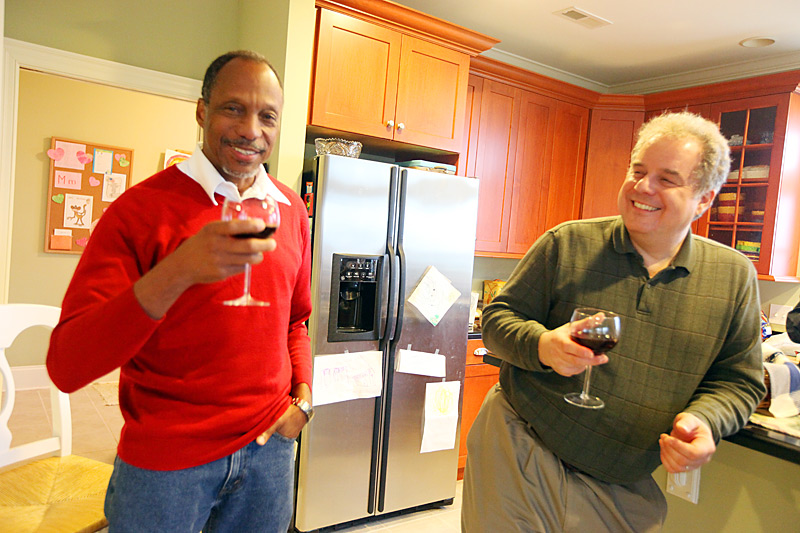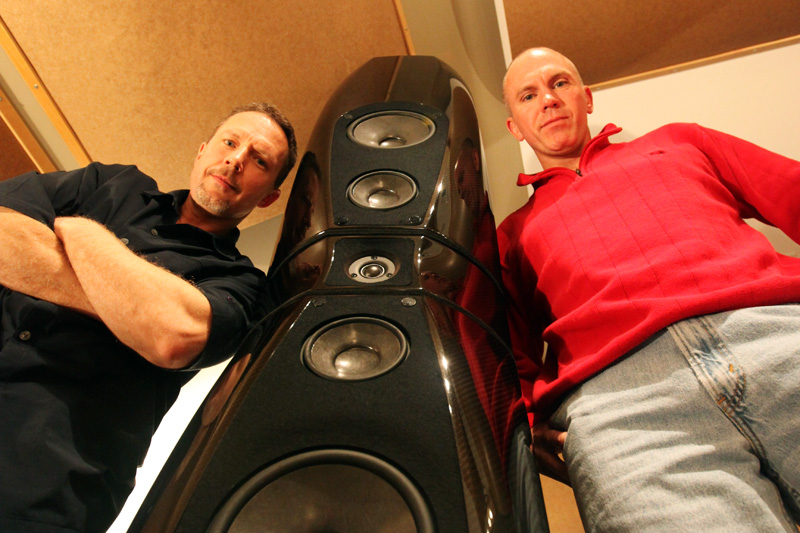| April 1, 2009
TWBAS 2009 Fulfils a Fusillade of Fetishism
Preparation
 An invitation to The
World’s Best Audio System 2009 (TWBAS 2009), held March 13-15, 2009, created a unique
opportunity to at long last meet Rockport Technologies’ flagship Arrakis loudspeakers. This was
more than music to mine ears. It signified the fulfillment of a dream. An invitation to The
World’s Best Audio System 2009 (TWBAS 2009), held March 13-15, 2009, created a unique
opportunity to at long last meet Rockport Technologies’ flagship Arrakis loudspeakers. This was
more than music to mine ears. It signified the fulfillment of a dream.
The Rockports would be driven by Behold processing and power amplifiers,
and a Black Box music server from Blue Smoke Entertainment Systems. Shunyata Research would supply power cords and line conditioners, and Crystal Cable the speaker cables
and digital interconnects. Harmonic
Resolution Systems would install vibration isolation racks to house the electronics.
And Terry Montlick Labs had
already certified and optimized the Music Vault for acoustic neutrality.
However, when Ultra Audio’s Jeffrey W. Fritz
requested that I write this article, I had grave doubts about my competence. Why on earth
would Jeff prefer me to his more prolific contributors? Am I skillful enough to
describe every last detail? What if TWBAS, with its total retail cost of over $360,000,
didn’t deliver? What if words failed me? What if . . . ?
I spent restless nights wrestling these gremlins, trying to
formulate a plan.
The ideal analogy
In biological research, one often views slides under a
microscope at different degrees of magnification: 10x, 100x, 1000x, etc. As the power of
resolution increases, more and more detail is revealed. Eventually, one may be privileged
to perceive an object through an electron microscope’s aperture. It becomes
abundantly clear that, even with heightened senses, one cannot immediately assimilate the
subtle nuances unveiled by this breathtakingly heterogeneous landscape; transparent,
layered, ethereal, seamless, palpable, palatable. One needs to spend time in this new
realm.
I concluded that comparing TWBAS to electron microscopy in
the optical domain would be an extremely interesting, invaluable undertaking. The auditory
resolving power of an ultra-high-resolution system not only allows one to hear more, but
ultimately, to comfortably discern more.
A common objective of optics and acoustics in these
circumstances is hyperfine delineation of the source material. Having accepted this
excitingly formidable challenge, I meticulously chose appropriate gourmet selections from
an infinite repository of noise and music (ā la Lionel
Seemungal), including samples of my own recordings.
I spent more than six weeks sorting recordings, including
some of my own, into seven categories: solo piano, percussion, vocals, live recordings,
instrumentals, Christmas chorales, and sound effects. Each genre was carefully sequenced,
on its own compilation CD, to provide enthralling experiences.
HDCD mastering was effected by my son Sean at Soundreaction
Studios. Thereafter I repeatedly listened to the demo discs (which totaled about ten
hours’ worth of recordings) through my reference system until their contents had
become totally familiar. Or so I thought.

TWBAS 2009
A formidable feast fuels five senses
The smell of new high-fidelity equipment always makes my
mouth water -- but it was the sight of TWBAS, and my response to touching these
components, that gave me goose pimples. I spent ten minutes rediscovering the glittering
array of new toys in Jeff’s Music Vault. Satisfied, I plunked myself down in his
sweet spot, psyched to hear, taste, and savor audio excellence.
Notwithstanding having prepared the eclectic sampler discs
described above, I attended TWBAS 2009 specifically to audition some special cuts.
In the liner note for her Water Music of the
Impressionists (CD, Delos D/CD 3006), pianist Carol Rosenberger describes her concert
grand piano: "The instrument also led me to double a bass note in [Debussy’s] La
cathédrale engloutie. The Bösendorfer Imperial boasts nine bass keys below the
lowest A on other pianos. These nine notes exist to add resonance to the rest of the
instrument, but I could not resist playing the lowest of them, the C which resonates at a
fundamental of 16Hz, in an open octave with the low C in the score, thus adding a
dimension to the passage which suggests the tolling of the great cathedral bell."
The sound Rosenberger elicits from the inherently supple
hammers of this majestic instrument is extremely gentle. The Rockport Arrakises painted a
huge, radiant sonic landscape modulated by watery illusions. The tolling of the great bell
was somewhat akin to a muted gong. I perceived its powerful, undulating waveform as
radiating effortlessly from the Bösendorfer’s bowels. I thrilled.
It is not difficult to distinguish members of the four
groups of conventional orchestral instruments: strings, woodwinds, brass, and percussion.
However, great care is required to balance the inherently complex soundstages of
recordings of large steel orchestras. Pan music becomes cacophonous when executed at
breakneck speed, and even trained ears find it difficult to differentiate the timbres of
different steelpan families. Two nights before the finals of the 2008 Panorama
Competition, I spent eight hours at the Trinidad All Stars’ panyard, recording 120
players rehearsing "Thunder Coming Down." Arranger Leon "Smooth"
Edwards selected an appropriate rendition for my percussion compilation disc.
TWBAS let me hear very deep into the intricate layers of
the All Stars’ performance, and easily discern the voices of the various steelpans.
Equally intriguing were the arranger’s sound effects, which mimic thunder and
lightning. The entire rhythm section was centered on the drummer, very finely etched at
the back. Instruments played from atop the rhythm rack were clearly delineated as such.
More than any other track I heard through TWBAS, this one conjured optical images closely
associated with electron microscopy. I will revisit this music time and again, slowly
absorbing its subtleties. Here was panmanship extraordinaire by a group of extremely
talented musicians from "Hell Yard."
Legendary composer, arranger, and producer Quincy Jones has
described the late Frank Sinatra as being one of three best male vocalists with whom he
has worked. On "The Lady Is a Tramp," from Sinatra’s Duets (24-karat
gold CD, Capitol/Digital Compact Classics GZS-1053), Ol’ Blue Eyes collaborates with
Luther Vandross. Apart from the lavish orchestration and scintillating arrangement, I am
partial to this recording because its mastering engineer was Doug Sax. TWBAS’s
transient response was lightning-quick and well articulated, with tight bass. The voices
of Sinatra and Vandross were crisp, focused, adjacent to each other, and immediate. It
seemed that the entire 87-piece orchestra was placed behind them in the studio. The
awesome power of the shimmering brass section was most impressive.
I’m an aficionado of live recordings, so We’re
All Together Again for the First Time (CD, Atlantic/Mobile Fidelity Sound Lab UDCD627)
was a very easy choice. The musicians -- Paul Desmond on tenor saxophone, Gerry Mulligan
on baritone sax, pianist Dave Brubeck, bassist Jack Six, and drummer Allan Dawson -- were
recorded at the Berlin Philharmonie on November 4, 1972. We all know that there are drum
solos, and then there are drum solos. Dawson’s six-minute outpouring on
Desmond’s celebrated "Take Five," written in the 5/4 time signature,
definitely fits the latter category. Gut-wrenching, visceral, testicular
are words that immediately came to mind. Eyes closed, I could see the musicians
fanned out in a semicircle on stage. A feeling of palpability and intimacy put me in a
front-row seat. I was enthralled.
Engineer Gert Palmcrantz recorded Swedish saxophonist Arne
Domnerus and his eight-piece band on May 24 and 25, 1994. Released as Shall We Dance?
(CD, Proprius PRCD9141), these tapes are excellent illustrations of how uncomplicated
technology can be used to record musicians in a natural acoustic environment with
startling results. In his liner note, Palmcrantz describes the process:
"Two big Didrik de Geer microphones were placed in
stereo position in front of the stage in the dining room of the Castle Hotel in Stockholm,
which has classic acoustics for dance music. A separate mike for vocals was placed at the
side of the band. The microphone signal passed through a line amp to a DAT recorder.
"All the musicians, many of whom were around in the
’50s, dug the ‘new/old’ mike set-up, and already after the first take I saw
eyebrows raised in recognition of the rich, dynamic band sound on the playback. Even the
bass and drums came across with surprising clarity without separate microphones."
Domnerus’s recording of Cole Porter’s "Begin
the Beguine" ensured that TWBAS would teleport me to the original event. The
intertransient silence between cymbal crashes was surreally, palpably discernible. This
intricate level of acoustic resolution reminded me of being "on song" in optics
-- as when one delineates hyperfine yellow lines of the mercury spectrum through the
eyepiece of a perfectly aligned prism spectrometer.

Simeon Sandiford with Albert Bellg
A bowl of volcanic soup
The fertile imagination of composer Alan Hovhaness has
always intrigued me, and in audio demonstrations I frequently use the third movement of
his Mount St. Helens Symphony, performed by Gerard Schwarz and the Seattle Symphony
Orchestra and recorded by John Eargle (CD, Delos DE3137). Hovhaness wrote this work to
commemorate St. Helens’ last eruption, on May 18, 1980, and this movement vividly
depicts the sounds of an erupting volcano, as Hovhaness describes:
"Eruption music (allegro, 2/2) is heard in the brass
-- the power of molten forces beneath the mountain. Chaos is sounded by stormy strings and
violent trombone glissandi, then a strict, blazing triple canon in 20 voices of winds,
brass and strings, followed by percussion. After the music of violence and destruction,
the dawn hymn returns in triumph."
Need I say more?
Jurassic Lunch on Black Friday
Jack Renner has been a friend and colleague since 1984.
Jack’s story of the acronym Telarc is hilarious (and far away from Advent
Recording Company). The Cleveland-based record label pioneered high-end digital recordings
in the late 1970s, using the first commercial Soundstream encoder designed and built by
Dr. Thomas G. Stockham Jr.
Recording engineer Michael Bishop contrived and recorded
many stunning digital sound effects for Erich Kunzel and the Cincinnati Pops’ The
Great Fantasy Adventure Album (CD, Telarc CD-80342), but the final track,
"Jurassic Lunch," is my unequivocal favorite. I asked Bishop, who is now one of
the principals of Five Four
Productions Ltd., to explain how he’d come up with his, ah, menu.
"I used multiple layers of jungle ambience recordings
to complete the overall picture of the Jurassic scene. The dinosaur’s roar was made
up from a complex layering of lion and tiger roars mixed with jet aircraft, thunder, and
train sound effects.
"The sound effect of T. rex eating his lunch
(his victim) was made from combined recordings of a horse eating carrots and grain (made
with the microphone very close), breaking wood, chewing of dry macaroni, and Jell-O
dropped on a flat surface."
The contumacious Tyrannosaurus rex vividly left a
long trail of chaos and destruction through a dense aural rain forest, relentlessly
pummeling into submission the shuddering earth with the metronomic beat of a funeral
march.
Petrified and lachrymose, I sat transfixed in Jeff’s
hot seat, hapless and hopeless. Candle in hand, I instinctively prayed for a swift end.
Suddenly, the beast’s blood-curdling roar unleashed violent gusts of infrasonic wind.
The room quivered as all hell broke loose. My candle’s timid flame was instantly
quenched, plunging Jeff’s Music Vault into pitch blackness. This was no illusion of
reality.
The seven-ton, 12-meter-tall theropod abruptly turned and
fixed me squarely in its sights. Instinctively, T. rex lunged menacingly at my
thorax from midway between the towering Arrakis loudspeakers. Its massive jaws were agape,
exposing gargantuan, milk-white teeth. The creature’s saliva-dripping tongue
flickered menacingly from side to side. Its piercingly bright, greedy eyes rolled
gleefully in anticipation of today’s lunch. I was about to be
devoured . . .
Incredible, indelible, extrasensory phenomena
With an electron microscope, I have perused the
architectural layout of one layer of a large-scale integrated circuit containing over
10,000 transistors. Only five other experiences have overwhelmed my senses and found
permanent residence in my subconscious, their indelible images touching my very soul. In
chronological order, they are: Niagara Falls, Canadian side; India’s Brindavan
Gardens and the Taj Mahal; the Grand Canyon; and St. Paul’s Cathedral, London. The
falls and the canyon were created by nature; the rest are manmade.
Having experienced TWBAS 2009 for an entire weekend, I
unreservedly add to this list the exciting aural phenomena I heard through it. Whatever
recording I listened to left me dumbstruck. With absolutely no hint of listener fatigue, I
was sucked into an abyssal vortex of apparently infinite pleasures. Each aural insight
fostered images of ultimate relaxation: snorkeling in Caribbean waters, taking a cruise in
an ocean liner, lying on rose petals, bathing in asses’ milk, swaying aimlessly in a
hammock strung between coconut trees. These sensations left me yearning to perceive and
discern more. Recollections of this emotional roller coaster will haunt me forever.
The prognosis for my own so-called reference system?
I’ll probably have to throw it away.

Doug Schneider and Jeff Fritz with the Arrakis
Inverting the audiophilic pyramid
What would be the consequence of inverting Jim Carroll’s audiophilic pyramid? More of us
would reside at the apex, fewer at base level. The intention is not that the structure
should topple, but rather that its shape gradually evolve into a delicious ice-cream cone.
The quintessence of life’s arts and sciences would then become more commonly
accessible to mankind.
In optics, greater numbers of the world’s population
would experience the fascinations of electron microscopy, while in acoustics, others would
seek to become audiophiles. This initiative could foster unprecedented growth of the
high-end industry. Success will ultimately depend on edifying the uninitiated.
Many people, disenchanted with the volatility of global
financial markets, need alternative investment opportunities. Efforts should be made to
expose them to high-resolution audio. If 10% of these neophytes could be converted, we
would have fulfilled our mission.
I hope that TWBAS 2009 evolves into a regular affair. It
could be hosted at such well-known international venues as the annual Consumer Electronics
Show. This first event was mind-boggling. I feel honored to have been among its elite cast
of pioneers.
Dedicated to fond memories of mother, Alice Eileen
Sandiford.
. . . Simeon Louis Sandiford
simeon@ultraaudio.com
|